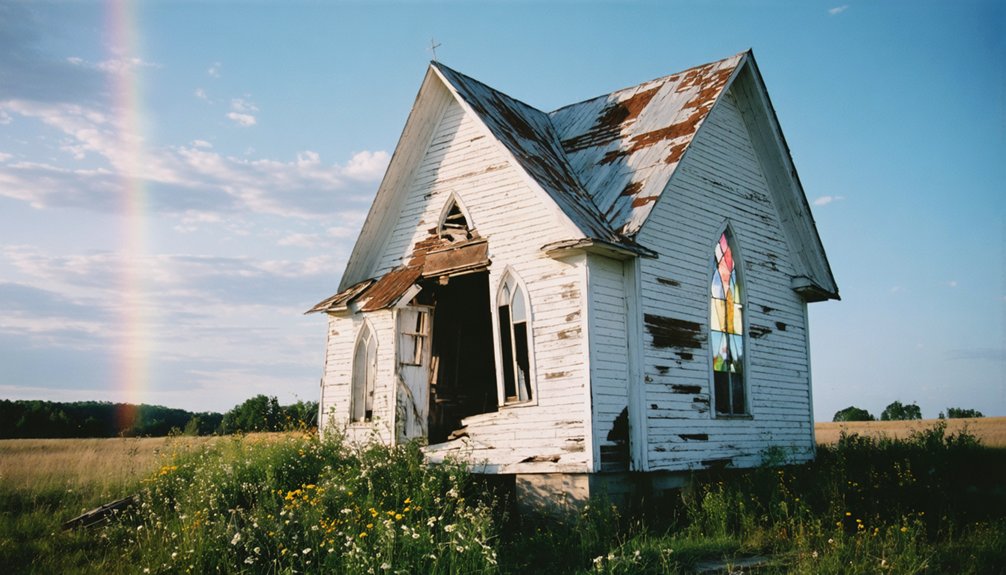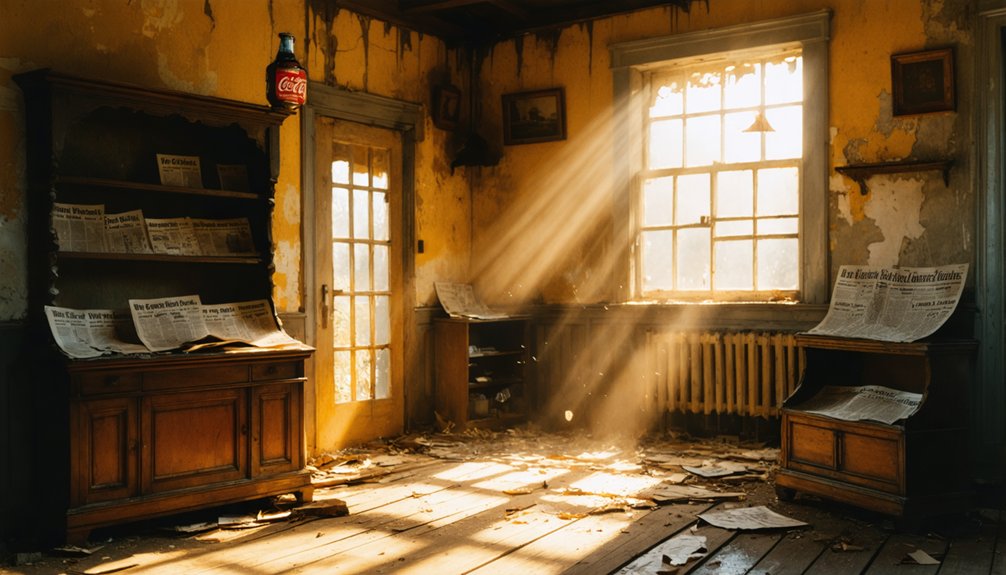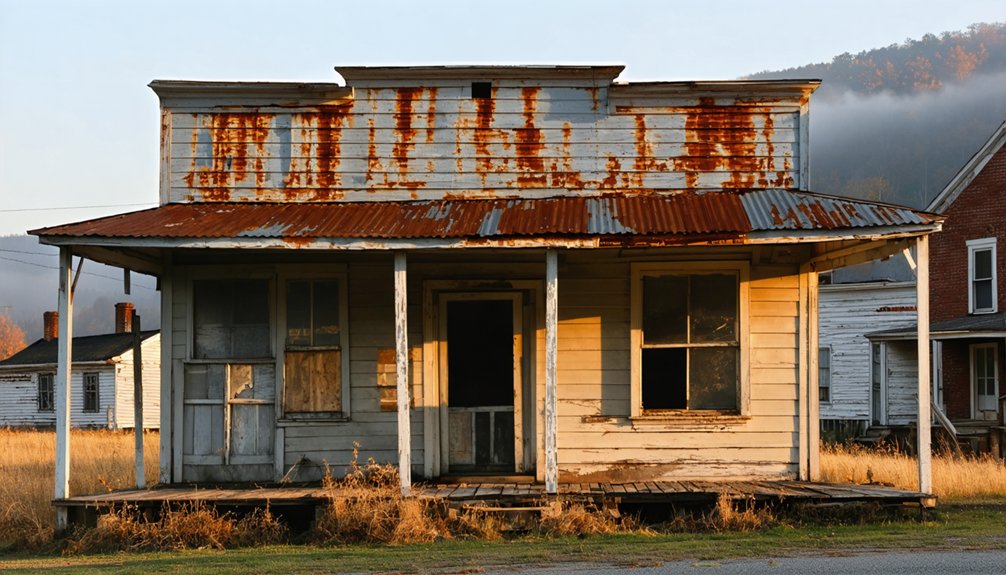You’ll find Blandville’s poignant story in western Kentucky, where this once-thriving county seat of Ballard County now stands as a ghost town of merely 30 residents. Established in 1842 and named after Revolutionary War scout Captain Bland Ballard, the town flourished until 1880, when a suspicious courthouse fire sparked a bitter political battle. After losing its county seat status to Wickliffe, Blandville’s population plummeted from 476, leaving behind haunting remnants of its frontier prosperity.
Key Takeaways
- Blandville transformed from a thriving county seat of 476 residents in 1880 to a ghost town with approximately 30 residents today.
- The courthouse fire of 1880 triggered Blandville’s decline when the county seat moved to Wickliffe, causing businesses and services to relocate.
- Historic structures are mostly gone or in ruins, including an abandoned college building and scattered remnants of its commercial past.
- The town lost essential services, government jobs, and infrastructure maintenance after losing its county seat status through a controversial vote.
- An old graveyard and historic house remain as primary physical evidence of Blandville’s once-prosperous existence as a regional hub.
The Birth of a Kentucky County Seat
When Kentucky’s state legislature carved Ballard County from parts of Hickman and McCracken counties in 1842, they established Blandville as its first county seat.
You’ll find this historic town nestled in western Kentucky at an elevation of 463 feet, where rich black loam and yellow clay subsoil characterize the landscape.
Named after Revolutionary War scout Captain Bland Ballard, Blandville’s founding marked a new era of local county governance for the region’s residents. As with other locations sharing this name, Blandville required place name disambiguation to distinguish it from similarly named towns.
The town’s official incorporation on January 1, 1845, cemented its status as the administrative heart of Ballard County.
The town’s first court session took place in June 1842 at the home of Jackson Stovall.
You can trace Blandville’s early history through its courthouse, which served as the center of civic life and legal proceedings, supporting a growing community that would reach 476 residents by 1880.
Rise to Regional Prominence
You’d find Blandville’s rise to regional prominence deeply rooted in its establishment as the county seat in 1842, which brought administrative power and a steady flow of visitors conducting official business.
The town’s strategic position helped it develop into a bustling commercial hub, complete with hotels, law offices, blacksmith shops, and various stores serving both locals and travelers. Similar to Paradise’s early days as Stoms Landing, Blandville grew from modest beginnings into a thriving settlement. Named after the renowned Captain Bland Ballard, the town attracted settlers seeking new opportunities in Ballard County.
County Seat Establishment Success
Shortly after its founding in 1842, Blandville quickly established itself as the county seat of the newly formed Ballard County, marking the beginning of its rise to regional prominence.
You’ll find that this pivotal moment in Blandville history transformed the small settlement, named after War of 1812 hero Captain Bland Ballard, into a thriving administrative center.
The establishment of a post office in 1842 helped cement the town’s importance as a communication hub for the region.
- The town’s incorporation in 1845 formalized its status as the county’s governmental hub
- Blandville’s strategic inland location initially served as an advantage for county-wide accessibility
- The town’s role as county seat sparked significant population growth, peaking at 476 residents by 1880
- As the administrative center, Blandville became the focal point for local commerce and governmental services, cementing its position as a regional leader
The devastating courthouse fire in 1880 marked a turning point for the town, leading to the eventual relocation of the county seat to Wickliffe.
Regional Commerce Hub Growth
During its heyday as the county seat, Blandville transformed into a bustling commercial center that served the broader Ballard County region.
You’d find a diverse mix of businesses that supported regional trade, including multiple hotels, law offices, and blacksmith shops. The town’s economic sustainability rested on its variety of essential services, from dry goods stores to a thriving wagon-making company.
If you’d visited in the late 1860s, you would’ve seen the impressive two-story brick college and picked up the latest news from the Ballard County News, which served readers for 15 years.
The town circle, anchored by the courthouse and city park, formed the heart of this vibrant community, though the lack of railroad access would later challenge its growth. Similar to Lexington’s early commercial decline when steamboats shifted commerce to river cities, Blandville struggled to maintain its economic prominence without rail connections.
The Courthouse Fire and Political Upheaval
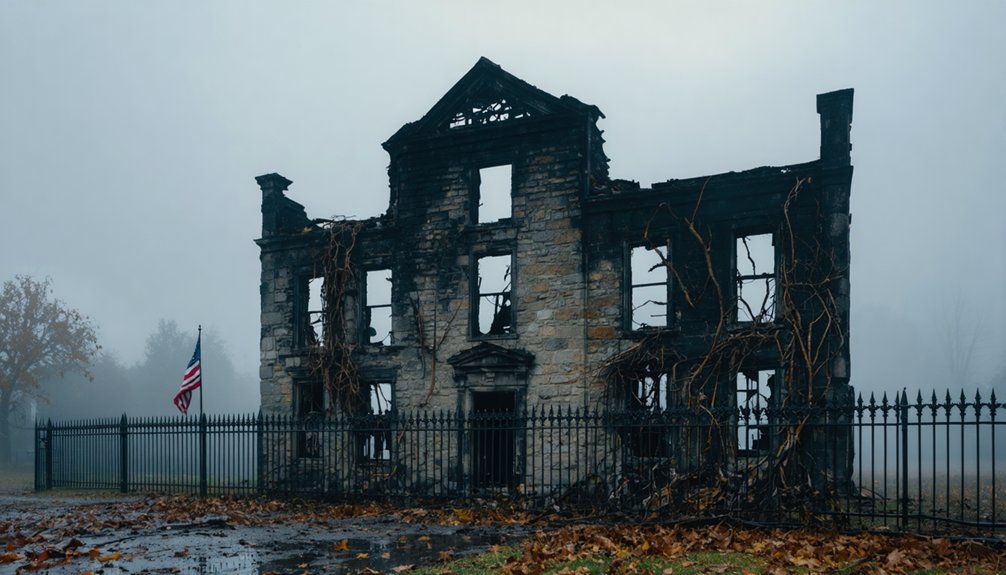
The devastating courthouse fire that struck Blandville on February 17, 1880, would spark an intense political battle that forever changed Ballard County’s landscape.
You’ll find that within months of the blaze, Wickliffe (then Fort Jefferson) secured the county seat through a decisive 1,760 to 570 vote.
Though Blandville’s supporters mounted legal challenges and forced another vote in 1884, despite Blandville’s determined resistance, including narrowing the margin to just 291 votes in the second election, Wickliffe’s new courthouse solidified its position as the county’s administrative center. The fire mirrored a pattern seen during the Civil War when 22 Kentucky courthouses were destroyed by flames. Like many institutions adapting to modern needs, the county’s records were later digitally archived using specialized content management systems.
Fatal February Flames
On February 17, 1880, flames engulfed Blandville’s brick courthouse, igniting not only the physical structure but also a political firestorm that would forever alter Ballard County’s landscape.
While the fire investigation never revealed a definitive cause, political motivations lurked beneath the surface, as the destruction conveniently served those seeking to relocate the county seat.
- The courthouse had stood as Blandville’s crown jewel since 1842, serving both Ballard and Carlisle counties.
- You’d find no fatalities reported that February night, yet the town’s future died in those flames.
- The fire’s timing raised suspicions, occurring just months before a significant county seat relocation vote.
- Within the broader context of Kentucky’s 19th-century courthouse fires, you’ll recognize this as part of a pattern where political disputes often ended in flames. Today, modern digital collection management helps preserve the historical records of such pivotal events in Kentucky’s courthouse history.
Contentious County Seat Battle
Following the courthouse’s destruction in February 1880, Blandville’s grip on county seat status quickly unraveled into a bitter political contest that would reshape Ballard County’s future.
The courthouse’s significance extended far beyond mere brick and mortar – it represented the heart of local governance and community pride.
You’ll find the political dynamics played out decisively in the May 6th election, where Fort Jefferson (later Wickliffe) secured the county seat by a commanding 1,760 to 570 vote.
Despite Blandville’s legal challenges and a second vote in 1884, Wickliffe’s emerging commercial importance proved unstoppable.
The shift marked more than just an administrative change – it reflected deeper tensions in post-Reconstruction Kentucky politics, ultimately contributing to Blandville’s decline from a peak population of 476 to eventual ghost town status.
Wickliffe’s Rising Influence
Destruction struck Blandville’s courthouse on February 17, 1880, igniting a chain of events that would cement Wickliffe’s ascendancy in Ballard County.
You’ll find that Wickliffe’s advantages were impossible to ignore – its strategic location and robust transportation links made it the natural choice for the new seat of power.
- Wickliffe’s position as a river port just six miles from Cairo, Illinois, gave it strong economic ties to this major commercial hub.
- Two major railroads served the town, connecting it to crucial north-south trade routes.
- The courthouse symbolism wasn’t lost on anyone – whoever controlled it controlled the county.
- The new courthouse, with its striking octagonal cupola, became a physical manifestation of Wickliffe’s authority.
The May 1880 vote confirmed what many already knew – Wickliffe’s time had come.
Economic Life in 19th Century Blandville
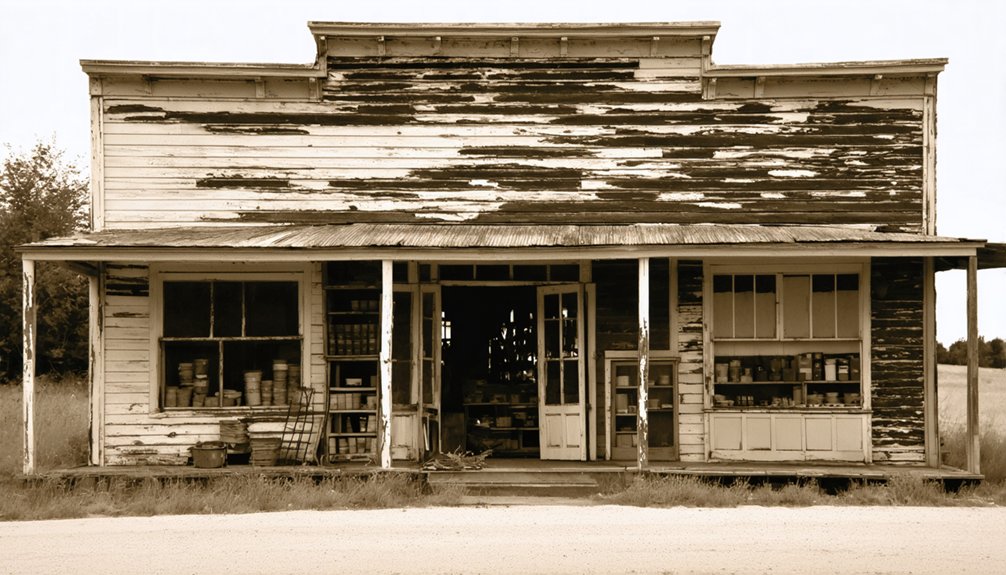
As Blandville emerged as a vital economic hub in 19th-century Kentucky, the town’s diverse economy centered around agriculture, commerce, and transportation networks.
You’d find tobacco plantations relying on enslaved labor alongside subsistence farmers growing corn and hemp. Local agricultural practices included mule breeding and livestock raising, while transportation routes connected farmers to broader markets.
The town’s commercial district bustled with two hotels, law offices, blacksmith shops, and various stores.
A vibrant downtown filled with hotels, blacksmiths and merchants served as Blandville’s beating commercial heart.
You’d see wagon makers crafting essential vehicles for transport, while the courthouse drew legal business until 1880. A two-story college and the Ballard County News newspaper reflected the town’s aspirations, though both proved short-lived.
These economic activities thrived on river navigation and improved roads, connecting Blandville to Southern and Midwestern markets.
From Bustling Town to Rural Ghost
The devastating courthouse fire of the 1880s marked the beginning of Blandville’s decline from a thriving county seat to a quiet ghost town. The loss of this vital institution triggered a domino effect of community decline, as businesses closed and residents moved away.
You’ll find that the town’s rural isolation deepened when railroads and major roads bypassed it in favor of neighboring Wickliffe.
- Courthouse operations relocated to Wickliffe, taking government jobs and services with them
- Schools and churches shuttered as population dwindled
- Local shops and businesses closed due to diminishing customer base
- Infrastructure deteriorated without tax revenue for maintenance
Today, you’ll see only scattered houses where a bustling town once stood, with most historic buildings either gone or in ruins.
Blandville’s transformation into a ghost town reflects the harsh realities of economic evolution in rural America.
Historical Legacy and Present-Day Remnants
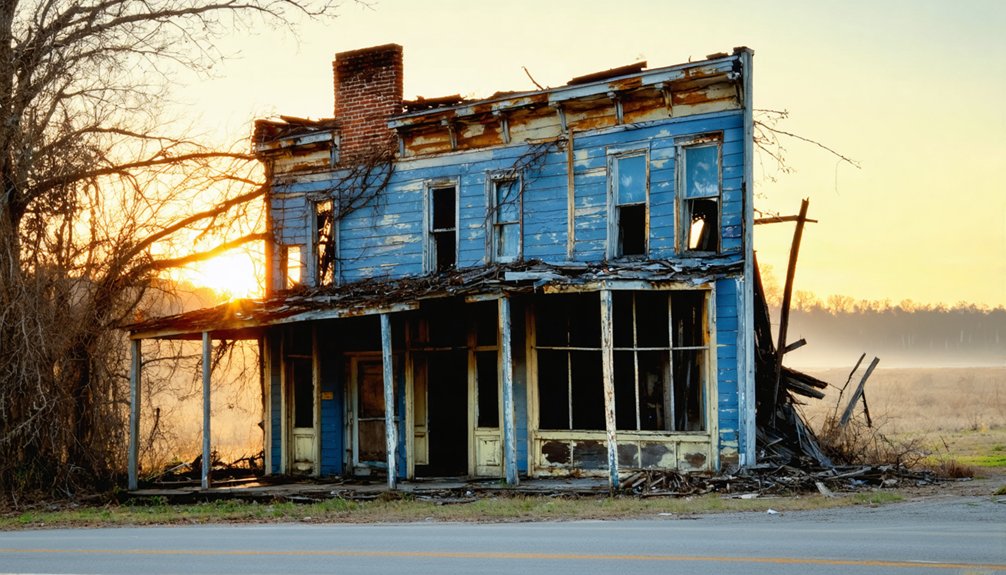
Despite its near-ghost town status today, Blandville’s historical significance remains deeply embedded in Kentucky’s early settlement period. Named after Captain Bland Ballard, the town served as Ballard County’s first governmental center from 1842 until the devastating courthouse fire of 1880.
You’ll find echoes of its former glory in the remnants that still stand – an old graveyard and a single historic house among scattered newer buildings.
The modern decline is stark: from 476 residents in 1880 to roughly 30 today. While you won’t find the bustling hotels, law offices, or blacksmith shops that once defined this commercial hub, Blandville’s quiet streets and abandoned college building tell a compelling story of regional power shifts in 19th-century rural Kentucky, preserved in time like a historical photograph.
Frequently Asked Questions
Are There Any Documented Paranormal Activities in Blandville’s Remaining Structures?
You won’t find documented paranormal sightings or ghost stories in Blandville’s remaining structures. Unlike Kentucky’s well-known haunted locations, there’s no verified evidence of supernatural activity in these abandoned buildings.
What Happened to the Contents of the Courthouse Before It Burned?
Like precious gems lost forever, you’ll find that courthouse artifacts and historical records – including deeds, court documents, and administrative papers – were mostly destroyed when flames engulfed the building in 1880.
How Do Current Residents Feel About Tourists Visiting Their Town?
You’ll find mixed local perspectives on tourist impact – some welcome potential economic benefits, while others worry about privacy and preservation. Without direct resident quotes, exact feelings remain uncertain.
Were There Any Famous Outlaws or Notable Crimes in Blandville?
You won’t find records of famous outlaws or notable crimes specific to Blandville. While Kentucky had its share of infamous criminals like the Harpe Brothers, none left their mark in this particular town.
Does Anyone Maintain the Old Cemetery, and Who Is Buried There?
While no official cemetery maintenance records exist, Kentucky law requires upkeep by legal owners. You won’t find detailed burial records, though tombstones likely mark 19th and early 20th-century local residents’ graves.
References
- https://www.fourriversexplorer.com/blandville-kentucky/
- https://www.youtube.com/watch?v=klm_zhcWcsA
- https://www.ghosttowns.com/states/ky/blandville.html
- https://www.onlyinyourstate.com/experiences/kentucky/12-ghost-towns-in-ky
- https://www.onlyinyourstate.com/experiences/kentucky/ghost-town-ky
- https://www.youtube.com/watch?v=CdlhDpJbpvQ
- https://www.kyatlas.com/ky-blandville.html
- https://en.wikipedia.org/wiki/Blandville
- https://en.wikipedia.org/wiki/Ballard_County
- https://samterryskentucky.com/f/bland-ballard
